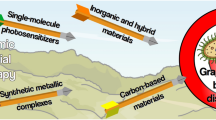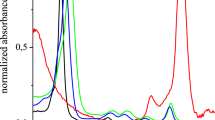Abstract
This study investigated, for the first time, the antimicrobial properties of polyethylene glycol-functionalized poly(N-phenylglycine) nanoparticles (PNPG-PEG NPs). PNPG-PEG NPs exhibit high extinction coefficient in the near-infrared (NIR) region; they can convert light energy into heat energy with high thermal transformation efficiency. Additionally, they can generate cytotoxic reactive oxygen species (ROS) upon light irradiation. Also, PNPG-PEG NPs are not cytotoxic. All these properties make them appropriate for combined dual-modal photothermal and photodynamic therapies. The antibacterial activity of PNPG-PEG NPs was assessed using Escherichia coli (Gram-negative) and Staphylococcus aureus (Gram-positive) pathogenic strains. The results revealed that NIR light (810 nm) irradiation for 10 min could kill effectively the planktonic bacteria and destroy Escherichia coli and Staphylococcus aureus biofilms. The results demonstrated that PNPG-PEG NPs represent a very effective nanoplatform for killing of pathogenic bacteria.
Graphical abstract








Similar content being viewed by others
References
Cabral JPS (2010) Water microbiology. Bacterial pathogens and water. Int J Env Res Public Health 7(10):3657–3703
Bannerman DD, Paape MJ, Lee JW, Zhao X, Hope JC, Rainard P (2004) Escherichia coli and Staphylococcus aureus elicit differential innate immune responses following intramammary infection. Clin Vaccine Immunol 11(3):463–472
Allocati N, Masulli M, Alexeyev MF, Di llio C (2013) Escherichia coli in Europe: an overview. Clin Environ Toxicol 10(12):6235–6254
Tong SYC, Davis JS, Eichenberger E, Holland TL, Fowler VG Jr (2015) Staphylococcus aureus infections: epidemiology, pathophysiology, clinical manifestations, and management. Clin Microbiol Rev 28(3):603–661
Hauser AR, Mecsas J, Moir DT (2016) Beyond antibiotics: new therapeutic approaches for bacterial infections. Clin Infect Dis 63(1):89–95
Hsiao CW, Chen HL, Liao ZX, Sureshbabu R, Hsiao HC, Lin SJ, Chang Y, Sung HW (2015) Effective photothermal killing of pathogenic bacteria by using spatially tunable colloidal gels with nano-localized heating sources. Adv Funct Mater 25:721–728
Wang S, Riedinger A, Li H, Fu C, Liu H, Li L, Liu T, Tan L, Barthel MJ, Pugliese G, De Donato F, D’Abbusco MS, Meng X, Manna L, Meng H, Pellegrino T (2015) Plasmonic copper sulfide nanocrystals exhibiting near-infrared photothermal and photodynamic therapeutic effects. ACS Nano 9:1788–1800
Zhu H, Cheng P, Chen P, Pu K (2018) Recent progress in the development of nearinfrared organic photothermal and photodynamic nanotherapeutics. Biomater Sci 6:746–765
Zhang H, Liang Y, Zhao H, Qi R, Chen Z, Yuan H, Liang H, Wang L (2020) Dual-mode antibacterial conjugated polymer nanoparticles for photothermal and photodynamic therapy. Macromol Biosci 20:1900301 (1–7)
Hu DF, Li H, Wang BL, Ye Z, Lei WX, Jia F, Jin Q, Ren KF, Ji J (2017) Surface-adaptive gold nanoparticles with effective adherence and enhanced photothermal ablation of methicillin-resistant Staphylococcus aureus Biofilm. ACS Nano 11:9330–9339
Turcheniuk K, Turcheniuk V, Hage CH, Dumych T, Bilyy R, Bouckaert J, Héliot L, Zaitsev V, Boukherroub R, Szunerits S (2015) Highly-effective photodynamic inactivation of E. coli using gold nanorods/SiO2 core–shell nanostructures with embedded verteporfin. Chem Commun 51:16365–16368
Jijie R, Dumych T, Chengnan L, Bouckaert J, Turcheniuk K, Hage CH, Heliot L, Cudennec B, Dumitrascu N, Boukherroub R, Szunerits S (2016) Particle-based photodynamic therapy based on indocyanine green modified plasmonic nanostructures for inactivation of a Crohn’s disease-associated Escherichia coli strain. J Mater Chem B 4:2598–2605
D'Agostino A, Taglietti A, Desando R, Bini, M, Patrini M, Dacarro G, Cucca L, Pallavicini P, Grisoli P (2017) Bulk surfaces coated with triangular silver nanoplates: Antibacterial action based on silver release and photo-thermal effect. Nanomaterials 7:7
Xiao JW, Fan SX, Wang F, Sun LD, Zheng XY, Yan CH (2014) Porous Pd nanoparticles with high photothermal conversion efficiency for efficient ablation of cancer cells. Nanoscale 6:4345–4351
Tao B, Lin C, Deng Y, Yuan Z, Shen X, Chen M, He Y, Peng Z, Hu Y, Cai K (2019) Copper nanoparticles-embedded hydrogel for killing bacteria and promoting wound healing with photothermal therapy. J Mater Chem B 7:2534–2548
Jia X, Ahmad I, Yang R, Wang C (2017) Versatile graphene-based photothermal nanocomposites for effectively capturing and killing bacteria, and for destroying bacterial biofilms. J Mater Chem B 5:2459–2467
Budimir M, Jijie R, Ye R, Barras A, Melinte S, Silhanek A, Markovic Z, Szunerits S, Boukherroub R (2019) Efficient capture and photothermal ablation of planktonic bacteria and biofilms using reduced graphene oxide–polyethyleneimine flexible nanoheaters. J Mater Chem B 7:2771–2781
Halouane F, Jijie R, Meziane D, Li C, Singh SK, Bouckaert J, Jurazek J, Kurungot S, Barras A, Li M, Boukherroub R, Szunerits S (2017) Selective isolation and eradication of E. coli associated with urinary tract infections using anti-fimbrial modified magnetic reduced graphene oxide nanoheaters. J Mater Chem B 5:8133–8142
Hong G, Diao S, Antaris AL, Dai H (2015) Carbon nanomaterials for biological imaging and nanomedicinal therapy. Chem Rev 115:10816–10906
Jiang BP, Zhang L, Zhu Y, Shen XC, Ji SC, Tan XY, Chenga L, Liang H (2015) Water-soluble hyaluronic acid–hybridized polyaniline nanoparticles for effectively targeted photothermal therapy. J Mater Chem B 3:3767–3776
Song XJ, Gong H, Yin SN, Cheng L, Wang C, Li ZW, Li YG, Wang XY, Liu G, Liu Z (2014) Ultra‐small iron oxide doped polypyrrole nanoparticles for in vivo multimodal imaging guided photothermal therapy. Adv Funct Mater 24:1194–1201
MacNeill CM, Wailes EM, Levi-Polyachenko NH (2013) A comparative study of the photothermal efficiency of electrically conducting poly(3,4-ethylenedioxythiophene)-based nanomaterials with cancer cells. J Nanosci Nanotechnol 13:3784–3791
Li Y, Jiang C, Zhang D, Wang Y, Ren X, Ai K, Chen X, Lu L (2017) Targeted polydopamine nanoparticles enable photoacousticimaging guided chemo-photothermal synergistic therapy of tumor. Acta Biomater 47:124–134
Maaoui H, Jijie R, Pan GH, Drider D, Caly D, Bouckaert J, Dumitrascu N, Chtourou R, Szunerits S, BoukherroubR, (2016) A 980nm driven photothermal ablation of virulent and antibiotic resistantGram-positive and Gram-negative bacteria strains using Prussian bluenanoparticles. J Colloid Interface Sci 480:63–68
Jiang BP, Zhang L, Guo XL, Shen XC, Wang Y, Zhu Y, Liang H (2017) Poly(N-phenylglycine)-based nanoparticles as highly effective and targeted near-infrared photothermal therapy/photodynamic therapeutic agents for malignant melanoma. Small 13:1602496–1602496
Chen H, Liang W, Zhu Z, Guo Z, Jian J, Jiang BP, Liang H, Shen XC (2018) Supercharged fluorescent protein functionalizedwater-soluble poly(N-phenylglycine) nanoparticles for highly effectiveimaging-guided photothermal therapy. Chem Commun 54:10292–10295
Tran VN, Dasagrandhi C, Truong VG, Kim YM, Kang HW (2018) Antibacterial activity of Staphylococcus aureus biofilm under combined exposure of glutaraldehyde, near-infrared light, and 405-nm laser. Plos One 13(8):e0202821
Allison RR, Downie GH, Cuenca R, Hu XH, Childs CJ, Sibata CH (2004) Photosensitizers in clinical PDT. Photodiagn Photodyn 1:27–42
Gorle G, Bathinapatla A, Chen YZ, Ling YC (2018) Near infrared light activatable PEI-wrapped bismuth selenidenanocomposites for photothermal/photodynamic therapy induced bacterialinactivation and dye degradation. RSC Adv 8:19827–19834
Al-Sharqi A, Apun K, Vincent M, Kanakaraju D, Bilung LM (2019) Enhancement of the antibacterial efficiency of silver nanoparticles against gram-positive and gram-negative bacteria using blue laser light. Int J Photoenergy 1–12
Deng K, Li C, Huang S, Xing B, Jin D, Zeng Q, Hou Z, Lin J (2017) Recent progress in near infrared light triggered photodynamic therapy. Small 13:1702299
Yin M, Li Z, Ju E, Wang Z, Dong K, Ren J, Qu X (2014) Multifunctional upconverting nanoparticles for near-infrared triggered and synergistic antibacterial resistance therapy. Chem Commun 50(2014):10488–10490
Xing C, Xu Q, Tang H, Liu L, Wang S (2009) Conjugatedpolymer/porphyrin complexes for efficient energy transfer and improving light-activated antibacterial activity. J Am Chem Soc 131:13117–13124
Ghayyem S, Swaidan A, Barras A, Dolci M, Faridbod F, Szunerits S, Boukherroub R (2021) Colorimetric detection of chromium (VI) ion using poly (N-phenylglycine) nanoparticles acting as a peroxidase mimetic catalyst. Talanta 226:12208
Wang L, He H, Zhang C, Sun L, Liu S, Wang S (2015) Antimicrobial activity of silver loaded MnO2 nanomaterials with different crystal phases against Escherichia coli. J Environ Sci 41:112–120
Braeken Y, Cheruku S, Ethirajan A, Maes W (2017) Conjugated polymer nanoparticles for bioimaging. Materials 10(12):1420
Corbitt TS, Ding L, Ji E, Ista LK, Ogawa K, Lopez GP, Schanzeb KS, Whitten DG (2009) Light and dark biocidal activity of cationic poly(aryleneethynylene) conjugated polyelectrolytes. Photochem Photobiol Sci 8:998–1005
Wang Y, Li S, Liu L, Feng L (2018) Photothermal-responsive conjugated polymer nanoparticlesfor rapid and effective killing of bacteria. ACS Appl. Bio Mater. 1:27–32
Maric S, Vranes J (2017) Characteristics and significance of microbial biofilm formation. Period Biol 109(2):115–121
Yuwen L, Sun Y, Tan G, Xiu W, Zhang Y, Weng L, Teng Z, Wang L (2018) MoS2@polydopamine-Ag nanosheets withenhanced antibacterial activity for effective treatment of Staphylococcus aureus biofilms and wound infection. Nanoscale 10:16711–16720
Funding
This study is financially supported by the Centre National de la Recherche Scientifique (CNRS), the University of Lille, the Hauts-de-France region, and the CPER “Photonics 4 Society” for financial support. This work was partly supported by the French Renatech network.
Author information
Authors and Affiliations
Corresponding author
Ethics declarations
Conflict of interest
The authors declare no competing interests.
Additional information
Publisher's Note
Springer Nature remains neutral with regard to jurisdictional claims in published maps and institutional affiliations.
Supplementary Information
Below is the link to the electronic supplementary material.
Rights and permissions
About this article
Cite this article
Ghayyem, S., Barras, A., Faridbod, F. et al. Effective PDT/PTT dual-modal phototherapeutic killing of bacteria by using poly(N-phenylglycine) nanoparticles. Microchim Acta 189, 150 (2022). https://doi.org/10.1007/s00604-022-05181-0
Received:
Accepted:
Published:
DOI: https://doi.org/10.1007/s00604-022-05181-0




